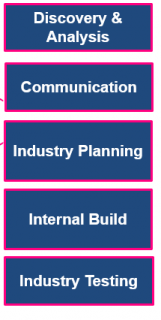T+2 Settlement is focused on reducing the trade settlement from T+3 days to T+2 days. DTCC, SIFMA, ICI, and the industry participants decided in 2014 to collaborate, identify, and assess the industry level requirements, rule changes, and proposed plan for a move to T+2 settlement. After significant industry feedback, the group has developed an implementation plan and impact analysis to drive the T+2 migration and testing plan.
DTCC and the Industry Working Group (IWG) have published the following T+2 requirements:
The roadmap plans to complete a move from a T+3 settlement cycle to a T+2 cycle for various U.S. Domestic securities by September 2017 for the following markets:
U.S. Equities
Corporate bonds
Municipal bonds
Unit Investment Trusts
T+2 will involve trade processing and asset servicing, including settlements/buy-ins, securities lending, and other components.
The move to T+2 will require the SEC and FINRA to approve a number of changes to their rules.
Review and analysis of all applicable processes.
Examination of all trading, settlement and downstream systems and processes.
Ascertain that processes and systems will be able to scale for reduced time frames caused by the shortening of the settlement cycle.

 212-220-6776
212-220-6776

